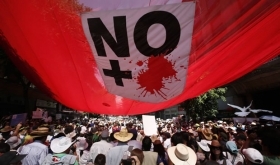Mexico‘s ability to swiftly apprehend suspects in the most high-profile cases, like the murder of the son of poet and campaigner Javier Sicilia, raises questions about the massive impunity rate when the media spotlight is off.
On June 9, Mexican authorities arrested Kineret Orozco, alias “El Chikinarco,” in the latest in a series of blows against the Cuernavaca-based leadership of the South Pacific Cartel (formerly the Beltran Leyva Organization).
The army said that Orozco, who was the group’s leader in the southern city of Cuernavaca, was stopped in the company of two other men and with two assault rifles. His arrest follows the May 24 detention of Jesus Radilla, Orozco’s uncle and predecessor as local South Pacific leader.
Days earlier, on May 19, the army detained Victor Manuel Valdes Arteaga, who they said had worked as Radilla’s boss. Hours later, they arrested a local police commander, Juan Bosco, for his alleged collusion with the South Pacific Cartel.
In short, the last few weeks have brought a mountain of heat on the South Pacific Cartel’s Cuernavaca operations, and for good reason. The government has had the group in its sights since the March murder of Juan Francisco Sicilia, which was allegedly carried out by Radilla and his crew following a bar-room argument. The killing of Sicilia, son of a well-known poet, sparked widespread outrage and gave rise to a series of anti-violence protests that were harshly critical of the government as well as of the criminal groups.
The takedown of the South Pacific Cartel continues a longtime pattern for Mexican authorities: once a crime crosses a certain threshold of media attention and public pressure, the previously powerless police snap into action and summarily arrest all of the responsible parties.
Such was the case with the February murder of American Immigration and Customs Enforcement (ICE) Agent Jaime Zapata, which was followed within weeks by the arrest of an alleged Zetas boss behind the shooting. Likewise the Tamaulipas massacres that shocked the country in April resulted in the swift capture of 73 people allegedly involved. Mexico’s recent history overflows with similar episodes.
This dynamic is, in one sense, encouraging: Mexico’s much-maligned police are capable of delivering arrests in the biggest cases. But in the context of 98 percent impunity for all crimes committed in Mexico, the success of Mexican authorities in Cuernavaca and in other high-profile cases raises more questions than it answers. The most obvious among them: Why do authorities need a public outcry to suspend their customary inefficiency and pursue suspects with all due rigor? Why isn’t the mere existence of a kidnapping or murder victim enough, regardless of the TV cameras?
At best, this indicates an overstretched criminal justice system that is motivated primarily by media attention and public shaming. (One darker theory is that the government doesn’t even search for the guilty party in such episodes, merely a convenient patsy.) While there’s nothing wrong with security agencies responding to public concerns, the fact that a crime becoming a scandal is almost a necessary condition for effective police work is worrying.
One obvious issue is that media attention is fickle, and the fact that a crime dominates the news doesn’t mean it is the most important threat to public security. Police resources should not chase the media spotlight.
Media attention and public outrage are simply limited quantities. Even if the media does focus on crimes worthy of government attention, this should not allow the police to ignore the overwhelming majority of crimes that escape public notice.
Mexicans need the authorities’ default approach to crime to be the aggressive and competent pursuit of suspects. Except in cases like Sicilia’s, where public outrage prods the government into action, this does not yet seem to be the case.

